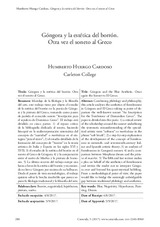Góngora y la estética del borrón. Otra vez el soneto al Greco
Góngora and the Blur Aesthetic. Once again the Sonnet to El Greco
Autor
Huergo Cardoso, Humberto
Editor
Universidad de Córdoba, UCOPressFecha
2017Materia
BorrónNegatividad
Hipérbaton
Pintura
Sueño
Blur
Negativity
Hyperbaton
Painting
Dream
METS:
Mostrar el registro METSPREMIS:
Mostrar el registro PREMISMetadatos
Mostrar el registro completo del ítemResumen
Maridaje de la filología y la filosofía
del arte, este trabajo tiene por objeto el estudio
de la estética del borrón en la poesía de Góngora
y la pintura del Greco, tomando como punto
de partida el conocido soneto “Inscripción para
el sepulcro de Domínico Greco”. El trabajo está
dividido en cinco partes: 1) el repaso crítico
de la bibliografía dedicada al soneto, haciendo
hincapié en la malinterpretación sistemática del
concepto de “suavidad” o morbidezza en el sintagma
“pincel süave”; 2) el estudio detallado de la
formación del concepto de “borrón” en la teoría
artística de Italia y España en los siglos XVI y
XVII; 3) el estudio de la estética del borrón en el
soneto al Greco de Góngora; 4) y la comparación
entre el sueño de Morfeo y la pintura de borrones.
5) La última sección del trabajo rompe una
lanza a favor de la estética del borrón y recomienda
no leer a Góngora por encima de su balbuceo.
Desde el punto de vista metodológico, el trabajo
quisiera salvar la brecha insalvable que parece separar
la filología tradicional y la filosofía del arte. Combining philology and philosophy,
this article analyses the aesthetics of formlessness
in Góngora and El Greco taking as point of departure
the well-known sonnet “An Inscription
for the Tombstone of Domenikos Greco”. The
paper is divided into five parts: 1) a critical review
of the scholarship around the sonnet underlining
the systematic misunderstanding of the specialized
artistic term “softness” or morbidezza in the
phrase “soft brush”; 2) a step-by-step explanation
of the development of the concept of formlessness
in sixteenth- and seventeenth-century Italian
and Spanish artistic theory; 3) an analysis of
formlessness in Gongora’s sonnet; 4) and a comparison
between Morpheus dream and the pittura
di macchie. 5) The fifth and last section makes
a plea on behalf of the aesthetics of formlessness
and invites the reader not to interpret Góngora
over and beyond his quasi-mystical babbling.
From a methodological point of view, the paper
would like to bridge the seemingly unbridgeable
gap between traditional philology and aesthetics.

